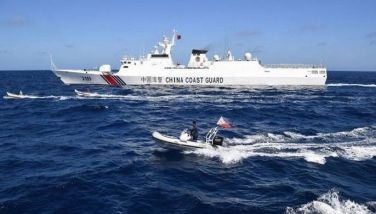US presses sea code of conduct
MANILA, Philippines - The United States yesterday stressed the need for freedom of navigation as it renewed its call for a maritime code of conduct between the Association of Southeast Asian Nations (ASEAN) and China after Beijing announced it would impose fishing restrictions in disputed waters.
US Ambassador Philip Goldberg reiterated Washington’s expression of concern over China’s unilateral declaration that it would impose fishing restrictions.
“It’s not done in consultation with other countries. It’s not done in the context of the Code of Conduct which we have urged ASEAN and China to develop,†Goldberg told The STAR yesterday as he called for “rules-based†kinds of activities to ease tension in the South China Sea.
Goldberg issued the statement as China yesterday clarified the fisheries restriction imposed by Hainan province, saying it was merely implementing an old law.
Manila earlier said it would not recognize China’s fisheries regulation and renewed its call for Beijing to abide by international rules.
Last week, State Department spokeswoman Jen Psaki described China’s move as “provocative and potentially dangerous.â€
Beijing’s move closely followed its declaration of an air defense identification zone in the East China Sea covering areas claimed by Japan.
China claims nearly the entire South China Sea, including the West Philippine Sea which lies within the Philippines’ 200-mile exclusive economic zone (EEZ).
Goldberg reaffirmed yesterday his government’s support for Manila’s peaceful modes of seeking to resolve the territorial dispute, including taking the case to the United Nations for international arbitration of the country’s maritime entitlements.
The arbitration has been rejected by Beijing, which prefers to settle all overlapping maritime claims bilaterally.
“We all should be working towards peaceful legal, diplomatic solutions,†Goldberg told The STAR. “The Philippines I think should be congratulated because those are the avenues that they are taking to try to resolve (disputes). The United States certainly supports that effort.â€
He emphasized that while the US has no territorial claims in the region, “we have a deep interest in free navigation in the air and in the sea.â€
“We are all concerned about miscalculations and unilateral actions in the sea and air around the entire part of East Asia – not just Southeast Asia, it’s East Asia as well – that will lead to any escalations,†Goldberg said.
How to deal with Beijing in the territorial dispute has been a divisive issue within ASEAN.
Clarification rejected
Meanwhile, the Department of Foreign Affairs (DFA) rejected yesterday China’s official clarification of the nature of its new fisheries law.
“The Chinese side has responded to our request for clarification by saying that the new regulation is an implementation of China’s fisheries law and covers the jurisdiction of Hainan province,†Foreign Affairs spokesman Raul Hernandez said yesterday. But he stressed the DFA “reiterates its strong protest which we have made on 28 June 2012 since the jurisdiction of Hainan province includes the Philippine territories and impinges on the Philippines’ EEZ.â€
Manila also reiterated its call for China to conform to international law, particularly the United Nations Convention on the Law of the Sea (UNCLOS).
“We are gravely concerned by this new regulation that would require foreign fishing vessels to obtain approval from Chinese regional authorities before fishing or surveying in a large portion of the South China Sea,†the DFA said.
The DFA said China’s latest move would only escalate tensions in the region.
‘Invasion’ downplayed
China’s growing aggressiveness – including its threat to invade Pag-Asa Island in the contested Spratlys region – has not caused alarm among the municipality’s 200 or so inhabitants, its mayor said.
Mayor Eugenio Bito-onon Jr. said that as far he is concerned, no amount of threat from other claimant countries like China can alter the way of living of his constituents in the island town.
“I am not the type of person who will just panic over this unverified report,†Bito-onon said, while expressing confidence that responsible national government agencies like the DFA and the Department of National Defense (DND) can handle the problem on behalf of his constituents.
Bito-onon stressed that if the reported China invasion plan this year of Pag-Asa is indeed true, he should have already received some advice from the DFA and the DND.
“So far, I haven’t received any – no guidance from our leaders as I believe that this (invasion plan) is not true,†the mayor of around 200 civilian islanders in Kalayaan town said.
He said he believes the Chinese leadership knows very well that the eyes of the world are on the Spratlys region and that any act of aggression would invite international condemnation. Worldwide condemnation is definitely more troubling to China than abandoning potential economic gains from seizing a territory in the region.
“What pride and prestige it will give them if they invade our impoverished town? What economy will they get from us?†Bito-onon said, after briefing school children in Puerto Princesa City on the current state of his island town.
Located within the hotly contested waters in the South China Sea, Pag-Asa is secured, on a rotation basis, by a handful of Filipino soldiers.
Aside from Filipino troops now guarding the country’s regime of islands in the West Philippine Sea, Vietnamese, Malaysian and Taiwanese forces are also on forward deployment in their occupied islets and reefs in region.
A confidential government report, meanwhile, states that China is maintaining an unchallenged naval presence in Bajo de Masinloc or Panatag (Scarborough) Shoal, possibly in preparation for the establishment of a permanent structure in the area that is well within Philippine territorial waters.
The report acknowledged that Beijing was using its growing military capability to assert its control over the area despite Manila’s diplomatic effort to resolve the territorial disputes.
Documents obtained by News5 showed that Chinese coast guard and marine surveillance vessels have been constantly present at Bajo de Masinloc as far back as April 2012. Apart from the ships, it appears China has also been placing buoys as a “prelude†to the establishment of a permanent presence, the government report said.
The Pambansang Lakas ng Kilusang Mamamalakaya ng Pilipinas (Pamalakaya), for its part, said Filipino fishermen should be credited for exercising the country’s legitimate claim over the South China Sea and not the Philippine government, which negotiates based on the “sinister agenda of the US government and the military might of Washington D.C.†With Pia Lee-Brago, DJ Sta. Ana, Michelle Zoleta, Jaime Laude
- Latest
- Trending





























